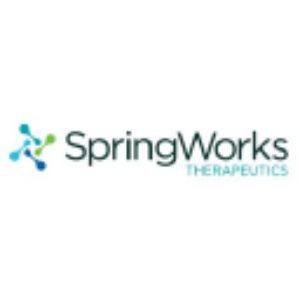SpringWorks Therapeutics Receives Positive CHMP Opinion for Mirdametinib for the Treatment of Adult and Pediatric Patients with NF1-PN
Rhea-AI Summary
The drug showed a manageable safety profile, with common side effects including rash, diarrhea, and musculoskeletal pain. Mirdametinib is already approved in the U.S. for similar indications.
Positive
- Strong efficacy data with 41% response rate in adults and 52% in children
- Potential to be first EU-approved therapy for both adults and children with NF1-PN
- Durable response with 88-90% of patients maintaining response for at least 12 months
- Already approved in the U.S. market
- Addresses an unmet medical need for ~135,000 EU patients
Negative
- Conditional marketing authorization suggests additional data may be required
- Significant side effects reported in >25% of patients
- Final EC approval still pending
Insights
CHMP recommendation for mirdametinib significantly expands SpringWorks' market reach, with EU approval likely in Q3 2025.
SpringWorks has cleared a critical regulatory hurdle with the positive CHMP opinion for mirdametinib in treating NF1-PN across both pediatric and adult populations. This conditional marketing authorization recommendation positions the drug to become the first approved therapy in the European Union for this indication, creating a significant first-mover advantage in a market with approximately 135,000 potential patients.
The clinical data supporting this recommendation is particularly strong, with the Phase 2b ReNeu trial demonstrating 41% objective response rate in adults and an even more impressive 52% in children. The durability of these responses is compelling - 88-90% of responders maintained benefits for at least 12 months, with about half showing responses lasting 24+ months. The median tumor volume reduction of approximately 42% across both populations represents meaningful clinical improvement.
What's particularly valuable is the drug's manageable safety profile coupled with multiple formulation options (including a dispersible tablet for children), which will enhance patient compliance and adoption. The dual-population approval strategy (adults and children ≥2 years) maximizes the addressable market and potential revenue.
With 30-50% of NF1 patients developing these tumors and up to 85% having inoperable cases, mirdametinib addresses a significant unmet need where surgical intervention is often impossible. The European Commission's final decision is anticipated in Q3 2025, potentially unlocking substantial revenue opportunities in a market where few therapeutic alternatives exist for these patients.
– If approved, mirdametinib is expected to be the first and only therapy in the European Union with marketing authorization for both adults and children with NF1-PN –
– Decision from European Commission expected in the third quarter of 2025 –
STAMFORD, Conn., May 23, 2025 (GLOBE NEWSWIRE) -- SpringWorks Therapeutics, Inc. (Nasdaq: SWTX), a commercial-stage biopharmaceutical company focused on severe rare diseases and cancer, announced today that the European Medicines Agency’s (EMA) Committee for Medicinal Products for Human Use (CHMP) has adopted a positive opinion recommending the granting of a conditional marketing authorization for mirdametinib, a MEK inhibitor, for the treatment of symptomatic, inoperable plexiform neurofibromas (PN) in pediatric and adult patients with neurofibromatosis type 1 (NF1) aged 2 years and above. The European Commission (EC) will review the CHMP opinion and is expected to make a final decision regarding the approval in the third quarter of 2025. If approved, mirdametinib will be available in 1 and 2 mg capsules and in a 1 mg dispersible tablet, which dissolves easily in water.
“The positive opinion from the CHMP brings us one step closer to delivering our medicine to both children and adults with NF1-PN in Europe, who we believe are in need of new therapeutic advances,” said Saqib Islam, Chief Executive Officer of SpringWorks. “Upon approval, we look forward to bringing mirdametinib to appropriate patients in Europe as quickly as possible.”
NF1 is a genetic disorder that affects approximately 3 in 10,000 people in the EU, or an estimated 135,000 people.1,2 Patients with NF1 have approximately a 30 to
“NF1-PN is a genetic disorder that can be highly morbid and unpredictable. It takes a significant physical and emotional toll on patients and their caregivers, and there have been limited treatment options available,” said Ignacio Blanco, MD, PhD, Chairman of the National Reference Center for Adult Patients with Neurofibromatosis at Hospital Universitari Germans Trias i Pujol, Spain. “Surgical removal of plexiform neurofibromas can be challenging and is often not possible, so if approved, mirdametinib could be an important treatment option for children and adult patients in Europe.”
The CHMP opinion was based on the Marketing Authorization Application (MAA) for mirdametinib, which was validated by the EMA in August 2024. The MAA centered on the primary results from the Phase 2b ReNeu trial, which enrolled 114 patients with NF1-PN age 2 years or older (58 adults and 56 pediatric patients). The study met the primary endpoint of confirmed objective response rate (ORR), as assessed by blinded independent central review, demonstrating an ORR of
Mirdametinib demonstrated a manageable safety and tolerability profile. The most common adverse events (>
Mirdametinib is approved in the U.S. for the treatment of adult and pediatric patients 2 years of age and older with neurofibromatosis type 1 (NF1) who have symptomatic plexiform neurofibromas (PN) not amenable to complete resection.
About the ReNeu Trial
ReNeu (NCT03962543) is an ongoing, multi-center, open-label, single arm, Phase 2b trial evaluating the efficacy, safety and tolerability of mirdametinib in patients ≥2 years of age with an inoperable NF1-associated PN causing significant morbidity. The study enrolled 114 patients to receive mirdametinib at a dose of 2 mg/m2 twice daily (maximum dose of 4 mg twice daily) without regard to food. Mirdametinib was administered orally in a 3-week on, 1-week off dosing schedule as either a capsule or dispersible tablet. The primary endpoint is confirmed objective response rate (ORR) defined as the proportion of patients with a ≥
About NF1-PN
Neurofibromatosis type 1 (NF1) is a rare genetic disorder that arises from mutations in the NF1 gene, which encodes for neurofibromin, a key suppressor of the MAPK pathway.10,11 NF1 is the most common form of neurofibromatosis, with an estimated global birth incidence of approximately 1 in 2,500 individuals.3,12 In the EU, NF1 affects approximately 3 in 10,000 people, or an estimated 135,000 people.1,2 The clinical course of NF1 is heterogeneous and manifests in a variety of symptoms across numerous organ systems, including abnormal pigmentation, skeletal deformities, tumor growth and neurological complications, such as cognitive impairment.13 Patients with NF1 have an 8 to 15-year mean reduction in their life expectancy compared to the general population.1
NF patients have approximately a
Surgical removal of these tumors can be challenging due to the infiltrative tumor growth pattern along nerves and can lead to permanent nerve damage and disfigurement.5 Up to approximately
About Mirdametinib
Mirdametinib is an oral, small molecule MEK inhibitor approved in the United States for the treatment of adult and pediatric patients 2 years of age and older with neurofibromatosis type 1 (NF1) who have symptomatic plexiform neurofibromas (PN) not amenable to complete resection.
The FDA and the European Commission have granted Orphan Drug designation for mirdametinib for the treatment of NF1.
About SpringWorks Therapeutics
SpringWorks is a commercial-stage biopharmaceutical company dedicated to improving the lives of patients with severe rare diseases and cancer. We developed and are commercializing the first and only FDA-approved medicine for adults with desmoid tumors and the first and only FDA-approved medicine for both adults and children with neurofibromatosis type 1 associated plexiform neurofibromas (NF1-PN). We are also advancing a diverse portfolio of novel targeted therapy product candidates for patients with both solid tumors and hematological cancers.
For more information, visit www.springworkstx.com and follow @SpringWorksTx on X, LinkedIn, Facebook, Instagram and YouTube.
Forward-Looking Statements
This press release contains “forward-looking statements” within the meaning of the Private Securities Litigation Reform Act of 1995, as amended, relating to our business, operations, and financial conditions, including but not limited to current beliefs, expectations and assumptions regarding the future of our business, future plans and strategies, our development and commercialization plans, our preclinical and clinical results, our expectations regarding the timing and results of the EMA’s review of our MAA for mirdametinib and our plans to begin its initial launch in the European Union in 2025, our plans to continue to study mirdametinib in pediatric and young adult patients with low-grade gliomas in a Phase 2 study, as well as relating to other future conditions. Words such as, but not limited to, “look forward to,” “believe,” “expect,” “anticipate,” “estimate,” “intend,” “plan,” “would,” “should” and “could,” and similar expressions or words, identify forward-looking statements. New risks and uncertainties may emerge from time to time, and it is not possible to predict all risks and uncertainties. Any forward-looking statements in this press release are based on management’s current expectations and beliefs and are subject to a number of risks, uncertainties and important factors that may cause actual events or results to differ materially from those expressed or implied by any forward-looking statements contained in this press release, including, without limitation, risks relating to: (i) the fact that topline or interim data from clinical studies may not be predictive of the final or more detailed results of such study or the results of other ongoing or future studies, (ii) the success and timing of our collaboration partners’ ongoing and planned clinical trials, (iii) the timing of our planned regulatory submissions and interactions, including the timing and outcome of decisions made by the FDA, EMA, and other regulatory authorities, investigational review boards at clinical trial sites and publication review bodies, (iv) whether EMA or other regulatory authorities will require additional information or further studies, or may fail or refuse to approve or may delay approval of our product candidates, including mirdametinib, (v) our ability to obtain regulatory approval of any of our product candidates or maintain regulatory approvals granted for our products, (vi) our plans to research, discover and develop additional product candidates, (vii) our ability to enter into collaborations for the development of new product candidates and our ability to realize the benefits expected from such collaborations, (viii) our ability to maintain adequate patent protection and successfully enforce patent claims against third parties, (ix) the adequacy of our cash position to fund our operations through any time period indicated herein, (x) our ability to establish manufacturing capabilities, and our collaboration partners’ abilities to manufacture our product candidates and scale production, and (xi) our ability to meet any specific milestones set forth herein.
Except as required by applicable law, we do not plan to publicly update or revise any forward-looking statements contained herein, whether as a result of any new information, future events, changed circumstances or otherwise. Although we believe the expectations reflected in such forward-looking statements are reasonable, we can give no assurance that such expectations will prove to be correct. Accordingly, readers are cautioned not to place undue reliance on these forward-looking statements.
For further information regarding the risks, uncertainties and other factors that may cause differences between SpringWorks’ expectations and actual results, you should review the “Risk Factors” in Item 1A of Part II of SpringWorks’ Quarterly Report on Form 10-Q for the quarter ended March 31, 2025 as well as discussions of potential risks, uncertainties and other important factors in SpringWorks’ subsequent filings.
Contacts:
Investors
Investors@Springworkstx.com
References
- Lee TJ, et al. Incidence and prevalence of neurofibromatosis type 1 and 2: a systematic review and meta-analysis. Orphanet J Rare Dis. 2023;18(1):292. doi:10.1186/s13023-023-02911-2.
- Eurostat. Population and population change statistics. Eurostat Statistics Explained. 2024. Available at: https://ec.europa.eu/eurostat/statistics-explained/index.php?title=Population_and_population_change_statistics. Accessed May 8, 2025.
- Prada C, Rangwala F, Martin L, et al. Pediatric Plexiform Neurofibromas: Impact on Morbidity and Mortality in Neurofibromatosis Type 1. J Pediatr. 2012;160(3):461-467. doi:10.1016/j.jpeds.2011.08.051.
- Miller DT, et al. Health supervision for children with neurofibromatosis Type 1. Pediatrics. 2019;143(5):e20190660.
- Kamaludin, Siti Nurhazwani, et al. “Plexiform neurofibromatosis with peripheral malignant nerve sheath tumor and scoliosis - more surveillance imaging needed?” Radiology case reports vol. 17,7 2388-2393. 6 May. 2022, doi:10.1016/j.radcr.2022.03.111.
- Needle M, Cnaan A, Dattilo J, et al. Prognostic signs in the surgical management of plexiform neurofibroma: The Children’s Hospital of Philadelphia experience, 1974-1994. J Pediatr. 1997;131(5):678-682. doi:10.1016/s0022-3476(97)70092-1.
- Ejerskov, C., Farholt, S., Nielsen, F.S.K. et al. Clinical Characteristics and Management of Children and Adults with Neurofibromatosis Type 1 and Plexiform Neurofibromas in Denmark: A Nationwide Study. Oncol Ther 11, 97–110 (2023). doi:10.1007/s40487-022-00213-4.
- Wolkenstein, P. et al. (2023) ‘French cohort of children and adolescents with neurofibromatosis type 1 and symptomatic inoperable plexiform neurofibromas: Cassiopea study’, European Journal of Medical Genetics, 66(5), p. 104734. doi:10.1016/j.ejmg.2023.104734.
- Moertel CL, Fisher MJ, Weiss BD, et al. ReNeu: A pivotal, Phase IIb trial of mirdametinib in adults and children with symptomatic neurofibromatosis type 1-associated plexiform neurofibroma. J Clin Oncol. 2024;JCO.24.01034. doi:10.1200/JCO.24.01034.
- Yap YS, McPherson JR, Ong CK, et al. The NF1 gene revisited - from bench to bedside. Oncotarget. 2014;5(15):5873-5892. doi:10.18632/oncotarget.2194.
- Rasmussen S, Friedman J. NF1 Gene and Neurofibromatosis 1. Am J Epidemiol. 2000;151(1):33-40. doi:10.1093/oxfordjournals.aje.a010118.
- Ferner R. Neurofibromatosis 1 and neurofibromatosis 2: a twenty first century perspective. The Lancet Neurology. 2007;6(4):340-351. doi:10.1016/s1474-4422(07)70075-3.
- Weiss, Brian D et al. “NF106: A Neurofibromatosis Clinical Trials Consortium Phase II Trial of the MEK Inhibitor Mirdametinib (PD-0325901) in Adolescents and Adults with NF1-Related Plexiform Neurofibromas.” Journal of clinical oncology: official journal of the American Society of Clinical Oncology vol. 39,7 (2021):797-806. doi:10.1200/JCO.20.02220.
- Gross A, Singh G, Akshintala S, et al. Association of plexiform neurofibroma volume changes and development of clinical morbidities in neurofibromatosis 1. Neuro Oncol. 2018;20(12):1643-1651. doi:10.1093/neuonc/noy067.
- Nguyen R, Dombi E, Widemann B, et al. Growth dynamics of plexiform neurofibromas: a retrospective cohort study of 201 patients with neurofibromatosis 1. Orphanet J Rare Dis. 2012;7(1):75. doi:10.1186/1750-1172-7-75.







